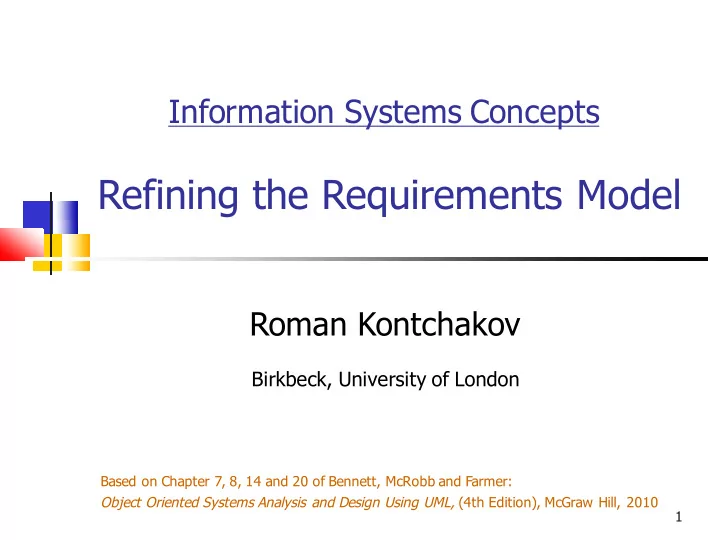

Information Systems Concepts Refining the Requirements Model Roman Kontchakov Birkbeck, University of London Based on Chapter 7, 8, 14 and 20 of Bennett, McRobb and Farmer: Object Oriented Systems Analysis and Design Using UML, (4th Edition), McGraw Hill, 2010 1
Outline n Software and Specification Reuse n Section 20.2 (pp. 585 – 586) n Section 8.2 (pp. 234 – 237) n Section 8.4 (pp. 246 – 247) n Section 8.5.1 – 8.5.2 (pp. 252 – 253) n Adding Further Structure (to Class Diagrams) n Section 8.3.1 – 8.3.3 (pp. 237 – 244) n Section 14.4.4 (pp. 409 – 410) 2
Stereotypes: Entity Classes <<entity>> Campaign Campaign title title campaignStartDate campaignStartDate campaignFinishDate campaignFinishDate Campaign getCampaignAdverts( ) getCampaignAdverts( ) addNewAdvert( ) addNewAdvert( ) n Stereotypes differentiate the roles of objects n Entity objects represent information and behaviour in the application domain 3
Stereotypes: Boundary Classes <<boundary>> User Interface::AddAdvertUI User Interface::AddAdvertUI startInterface( ) startInterface( ) assignStaff( ) assignStaff( ) selectClient( ) selectClient( ) User Interface::AddAdvertUI selectCampaign( ) selectCampaign( ) n Stereotypes differentiate the roles of objects n Boundary objects model interaction between the system and actors (and other systems), e.g., user interface 4
Stereotypes: Control Classes <<control>> Control::AddAdvert Control::AddAdvert showClientCampaigns( ) showClientCampaigns( ) showCampaignAdverts( ) showCampaignAdverts( ) AddAvert createNewAdvert( ) createNewAdvert( ) n Stereotypes differentiate the roles of objects n Control objects co-ordinate and control other objects (often correspond to Use Cases) 5
Association Classes 6
Why Reuse? n The arguments for reuse are n partly economic n saving time and effort in software development including software testing and quality assurance n partly concerned with quality n fewer defects n partly about business flexibility n faster time to market 7
How O-O Contributes to Reuse n Inheritance and Encapsulation n Two main forms of abstraction that O-O relies on to achieve reuse n Components n Patterns 8
Reuse: Encapsulation n allows one class or component to be replaced by another with different internal details, as long as they adhere to the same external interface n thus classes or components can be used in systems for which they were not originally designed n a group of classes can be encapsulated through aggregation or composition to become a reusable subassembly Universal Serial Bus (USB) http://en.wikipedia.org/wiki/Universal_Serial_Bus Plug and Play 9
Reuse: Inheritance n encourages identifying those aspects of a design or specification that has general application to a variety of situations or problems n allows the creation of new specialised classes when needed, with little effort “Do not reinvent the wheel!” http://en.wikipedia.org/wiki/Wheel http://images.google.co.uk/images?q=wheel&hl=en same circular form and central shaft 10
Reuse: Components n For example, a house (bricks, tiles, doors, windows, pipes, etc.), a home theatre (a big screen TV, a DVD player , a decoder , an amplifier , speakers, etc.), … n Software development has concentrated on inventing new solutions. Recently, the emphasis has shifted. Much software is now assembled from components that already exist. 11
Reuse: Patterns n next year , Information Systems Management 12
Adding Generalization Structure n A generalization structure can be added when two classes are similar in most respects, but differ in some details such as n behaviour (operations or methods) n data (attributes) n associations with other classes 13
A superclass A superclass StaffMember StaffMember {abstract} {abstract} Adding Generalization Structure 1..* 1..* 0..* 0..* allocated allocated staffName staffName Grade Grade staffNo staffNo gradeName gradeName staffStartDate staffStartDate calculate Bonus () calculate Bonus () assignNewStaffGrade () assignNewStaffGrade () getStaffDetails () getStaffDetails () Two Two Superclass Superclass subclasses subclasses associations are associations are inherited by inherited by subclasses subclasses AdminStaff AdminStaff AdminStaff CreativeStaff CreativeStaff qualification qualification calculateBonus () calculateBonus () calculateBonus () calculateBonus () calculateBonus () assignStaffContact () assignStaffContact () 14
Liskov Substitution Principle n In object interactions, it should be possible to treat a derived object as if it were a base object without integrity problems. n If the principle is not applied, then it may be possible to violate the integrity of the derived object. Prof Barbara Liskov 2009 A. M. Turing Award winner 15
Liskov Substitution Principle ChequeAccount Account accountName accountName balance balance Restructuring to credit() satisfy LSP credit() debit() MortgageAccount MortgageAccount ChequeAccount interestRate interestRate debit() calculateInterest() calculateInterest() - debit() Disinheritance of debit() means that the left-hand hierarchy is not Liskov compliant 16
Aggregation and Composition n Two special types of association n Aggregation represents a whole-part relationship between classes n Composition expresses a similar relationship but differs in showing a stronger form of ownership by the whole n Each part may belong to only one whole at a time. n When the whole is destroyed, so are all its parts. 17
Notation: Aggregation n A student could be in a number of modules n If a module is cancelled, students are not destroyed Module Student 1..* 0..* unfilled diamond denotes aggregation 18
Notation: Composition n An ingredient is in only one meal at a time n If you drop your meal on the floor , you probably lose the ingredients too Ingredient Meal 1 1..* filled diamond denotes composition 19
Take Home Messages n Software and Specification Reuse n Why Reuse n How O-O Contributes to Reuse n Adding Further Structure (to Class Diagrams) n Generalization/Specialization n Liskov Substituion Principle n Aggregation and Composition 20
Recommend
More recommend